

Compact Muon Solenoid
LHC, CERN
| CMS-B2G-18-001 ; CERN-EP-2018-279 | ||
| Search for a W' boson decaying to a vector-like quark and a top or bottom quark in the all-jets final state | ||
| CMS Collaboration | ||
| 17 November 2018 | ||
| JHEP 03 (2019) 127 | ||
| Abstract: A search for a heavy W' resonance decaying to one B or T vector-like quark and a top or bottom quark, respectively, is presented. The search uses proton-proton collision data collected in 2016 with the CMS detector at the LHC, corresponding to an integrated luminosity of 35.9 fb$^{-1}$ at $\sqrt{s} = $ 13 TeV. Both decay channels result in a final state with a top quark, a Higgs boson, and a b quark, each produced with significant energy. The all-hadronic decays of both the Higgs boson and the top quark are considered. The final-state jets, some of which correspond to merged decay products of a boosted top quark and a Higgs boson, are selected using jet substructure techniques, which help to suppress standard model backgrounds. A W' boson signal would appear as a narrow peak in the invariant mass distribution of these jets. No significant deviation in data with respect to the standard model background predictions is observed. Cross section upper limits on W' boson production in the top quark, Higgs boson, and b quark decay mode are set as a function of the W' mass, for several vector-like quark mass hypotheses. These are the first limits for W' boson production in this decay channel, and cover a range of 0.01 to 0.43 pb in the W' mass range between 1.5 and 4.0 TeV. | ||
| Links: e-print arXiv:1811.07010 [hep-ex] (PDF) ; CDS record ; inSPIRE record ; CADI line (restricted) ; | ||
| Figures | |

png pdf |
Figure 1:
The W' boson production and decays considered in the analysis. The analysis assumes equal branching fractions for W' boson to Bt and Tb and 50% for each VLQ to qH. |
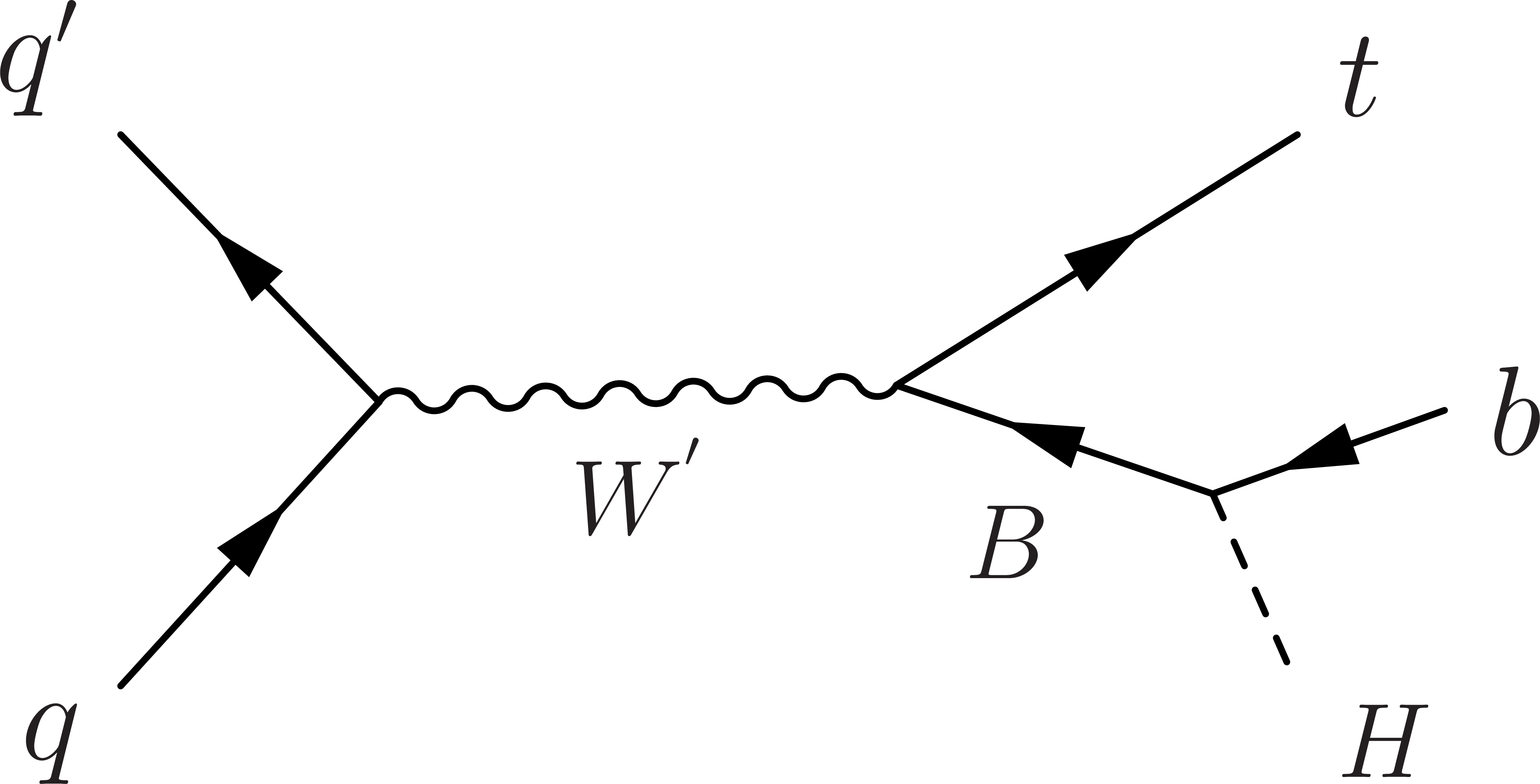
png pdf |
Figure 1-a:
A W' boson production and decay considered in the analysis. |

png pdf |
Figure 1-b:
A W' boson production and decay considered in the analysis. |

png pdf |
Figure 2:
Trigger efficiency as a function of $ {H_{\mathrm {T}}} $. Events are required to have $ {H_{\mathrm {T}}} > $ 1 TeV as is indicated by the red dashed line. The $ {H_{\mathrm {T}}} $ distributions of two W' signal hypotheses are shown for comparison, normalized to unit area. |

png pdf |
Figure 3:
Normalized distributions of the discriminating variables in $ {{\mathrm {t}\overline {\mathrm {t}}}} $, QCD, and signal MC simulation. The distributions shown, from upper left to lower right, are of the variables: the maximum subjet b tag, $\tau _3$/$\tau _2$, and $m_{\mathrm {SD}}^ {\mathrm {t}}$, all used for top quark discrimination, and the double-b tag discriminant and $m_{\mathrm {SD}}^ {\mathrm {H}} $ used for tagging candidate Higgs boson jets. The QCD distributions are extracted from events with the generator-level $ {H_{\mathrm {T}}} > $ 1 TeV. Each variable distribution in this set of figures requires an event that passes the selection on all other variables in order to preserve possible correlations. |
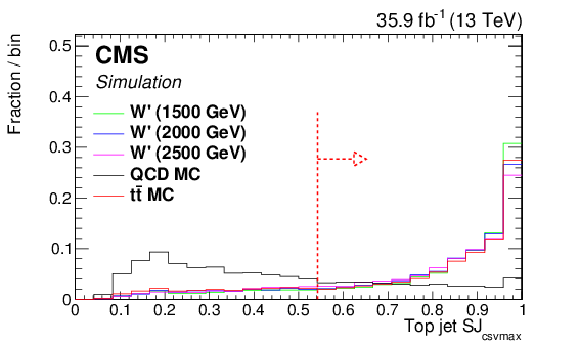
png pdf |
Figure 3-a:
Normalized distribution of the maximum subjet b tag, discriminating variable used for top quark discrimination, in $ {{\mathrm {t}\overline {\mathrm {t}}}} $, QCD, and signal MC simulation. The QCD distributions are extracted from events with the generator-level $ {H_{\mathrm {T}}} > $ 1 TeV. This variable distribution requires an event that passes the selection on other variables shown in Fig. 3 in order to preserve possible correlations. |
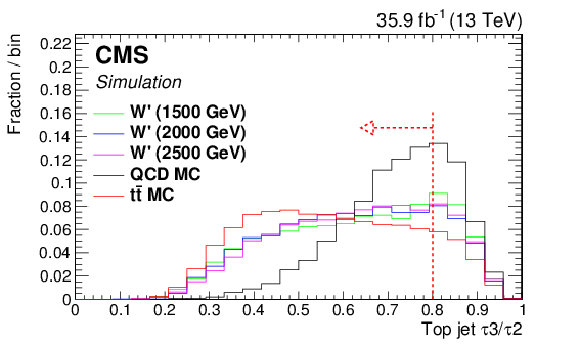
png pdf |
Figure 3-b:
Normalized distribution of $\tau _3$/$\tau _2$, discriminating variable used for top quark discrimination, in $ {{\mathrm {t}\overline {\mathrm {t}}}} $, QCD, and signal MC simulation. The QCD distributions are extracted from events with the generator-level $ {H_{\mathrm {T}}} > $ 1 TeV. This variable distribution requires an event that passes the selection on other variables shown in Fig. 3 in order to preserve possible correlations. |
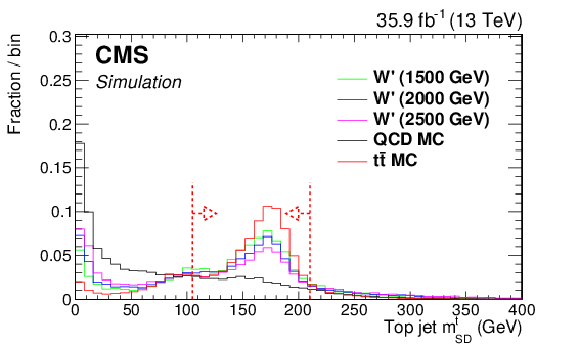
png pdf |
Figure 3-c:
Normalized distribution of $m_{\mathrm {SD}}^ {\mathrm {t}}$, discriminating variable used for top quark discrimination, in $ {{\mathrm {t}\overline {\mathrm {t}}}} $, QCD, and signal MC simulation. The QCD distributions are extracted from events with the generator-level $ {H_{\mathrm {T}}} > $ 1 TeV. This variable distribution requires an event that passes the selection on other variables shown in Fig. 3 in order to preserve possible correlations. |
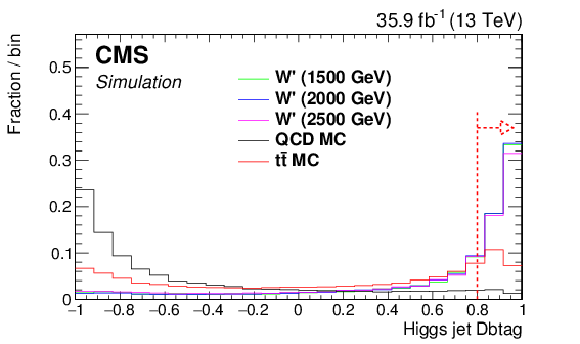
png pdf |
Figure 3-d:
Normalized distribution of the double-b tag discriminant, discriminating variable used for tagging candidate Higgs boson jets, in $ {{\mathrm {t}\overline {\mathrm {t}}}} $, QCD, and signal MC simulation. The QCD distributions are extracted from events with the generator-level $ {H_{\mathrm {T}}} > $ 1 TeV. This variable distribution requires an event that passes the selection on other variables shown in Fig. 3 in order to preserve possible correlations. |

png pdf |
Figure 3-e:
Normalized distribution of $m_{\mathrm {SD}}^ {\mathrm {H}} $, discriminating variable used for tagging candidate Higgs boson jets, in $ {{\mathrm {t}\overline {\mathrm {t}}}} $, QCD, and signal MC simulation. The QCD distributions are extracted from events with the generator-level $ {H_{\mathrm {T}}} > $ 1 TeV. This variable distribution requires an event that passes the selection on other variables shown in Fig. 3 in order to preserve possible correlations. |
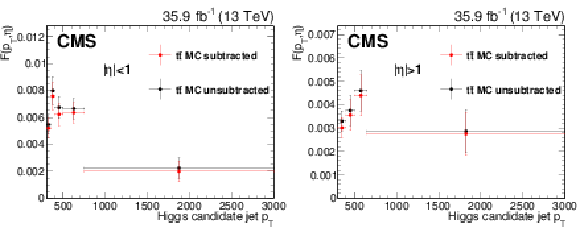
png pdf |
Figure 4:
Transfer function $ {F({p_{\mathrm {T}}},\eta)} $ used for estimation of the QCD background in the signal region, shown in the central (left) and forward (right) $\eta $ regions. The error bars represent the statistical uncertainty in $ {F({p_{\mathrm {T}}},\eta)} $ only. |

png pdf |
Figure 4-a:
Transfer function $ {F({p_{\mathrm {T}}},\eta)} $ used for estimation of the QCD background in the signal region, shown in the central $\eta $ region. The error bars represent the statistical uncertainty in $ {F({p_{\mathrm {T}}},\eta)} $ only. |

png pdf |
Figure 4-b:
Transfer function $ {F({p_{\mathrm {T}}},\eta)} $ used for estimation of the QCD background in the signal region, shown in the forward $\eta $ region. The error bars represent the statistical uncertainty in $ {F({p_{\mathrm {T}}},\eta)} $ only. |

png pdf |
Figure 5:
Reconstructed W' mass distributions ($ {m_{\mathrm {{\mathrm {t}} {\mathrm {H}} {\mathrm {b}}}}} $) in the b candidate inverted validation region (VR) shown for data and background contributions. Several signal hypotheses are shown to demonstrate the low signal contamination. The background uncertainty includes all systematic and statistical uncertainties. |

png pdf |
Figure 6:
Reconstructed W' mass distributions ($ {m_{\mathrm {{\mathrm {t}} {\mathrm {H}} {\mathrm {b}}}}} $) for the simulated QCD events in the signal region for the purposes of validation. The agreement given the systematic uncertainties is at the 1 standard deviation level. The background uncertainty takes into account all systematic and statistical uncertainties. |
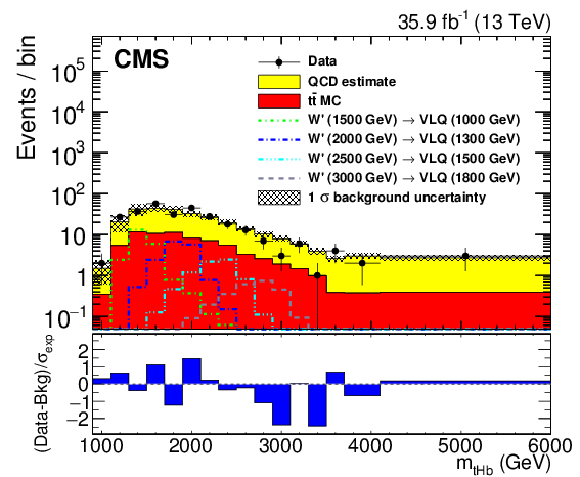
png pdf |
Figure 7:
Reconstructed W' mass distributions ($ {m_{\mathrm {{\mathrm {t}} {\mathrm {H}} {\mathrm {b}}}}} $) in the signal region, compared with the distributions of estimated backgrounds, and several benchmarks models. The signal distributions include the contributions from W' decays to both the $ {\mathrm {T}} $ and $ {\mathrm {B}} $ assuming equal branching fractions. The uncertainties shown in the hatched region contain both statistical and systematic uncertainties of all background components. |

png pdf |
Figure 8:
The W' boson 95% CL production cross section limits. The expected limits (dashed) and observed limits (solid), as well as the W' boson theoretical cross section and the PDF and scale normalization uncertainties are shown. The bands around the expected limit represent the $\pm $1 and ${\pm}$2$\sigma _{exp}$ uncertainties in the expected limit. The limits for low- (upper left), medium- (upper right), and high- (lower) mass VLQ mass ranges, defined in Table 2, are shown. |

png pdf |
Figure 8-a:
The W' boson 95% CL production cross section limits. The expected limits (dashed) and observed limits (solid), as well as the W' boson theoretical cross section and the PDF and scale normalization uncertainties are shown. The bands around the expected limit represent the $\pm $1 and ${\pm}$2$\sigma _{exp}$ uncertainties in the expected limit. The limits for low-mass VLQ mass ranges, defined in Table 2, are shown. |
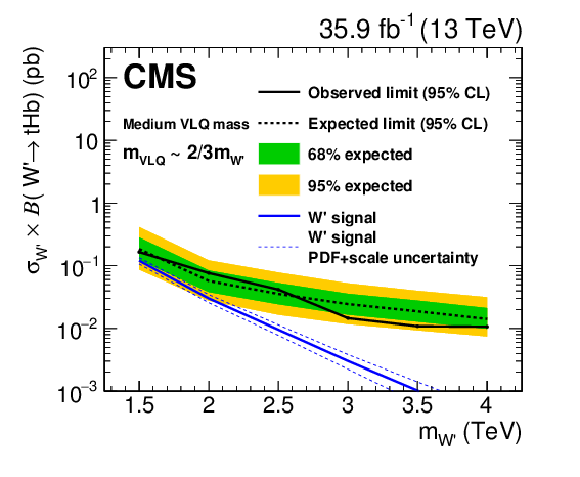
png pdf |
Figure 8-b:
The W' boson 95% CL production cross section limits. The expected limits (dashed) and observed limits (solid), as well as the W' boson theoretical cross section and the PDF and scale normalization uncertainties are shown. The bands around the expected limit represent the $\pm $1 and ${\pm}$2$\sigma _{exp}$ uncertainties in the expected limit. The limits for medium-mass VLQ mass ranges, defined in Table 2, are shown. |

png pdf |
Figure 8-c:
The W' boson 95% CL production cross section limits. The expected limits (dashed) and observed limits (solid), as well as the W' boson theoretical cross section and the PDF and scale normalization uncertainties are shown. The bands around the expected limit represent the $\pm $1 and ${\pm}$2$\sigma _{exp}$ uncertainties in the expected limit. The limits for high-mass VLQ mass ranges, defined in Table 2, are shown. |
| Tables | |

png pdf |
Table 1:
Selection regions used in the analysis. Tagging discriminator selections and regions described in the text are explicitly defined here. The signal region (SR) is used to set cross section upper limits, the control regions (CRN) are used to estimate the QCD background, and the validation region (VR) is used to validate the background estimation procedure. |

png pdf |
Table 2:
The selection efficiency (%) for each signal mass point in the analysis. |
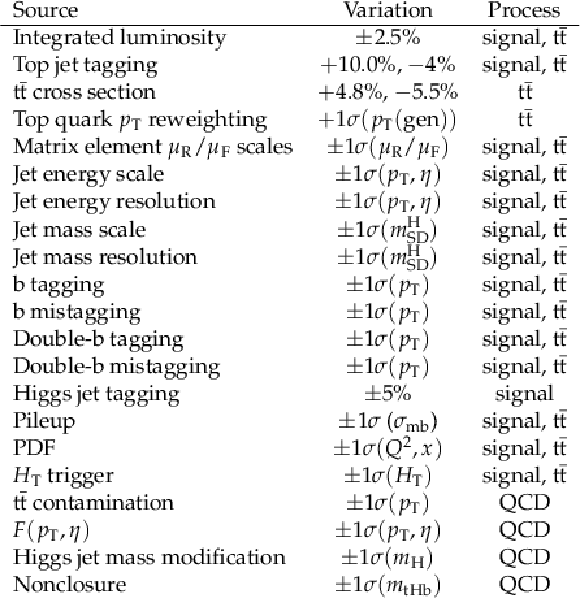
png pdf |
Table 3:
Sources of systematic uncertainty affecting the $ {m_{\mathrm {{\mathrm {t}} {\mathrm {H}} {\mathrm {b}}}}} $ distribution. Sources that list the systematic variation as $ \pm$1$ \sigma $ depend on the distribution of the variable given in the parentheses, while those that list the variation in percent are rate uncertainties. |
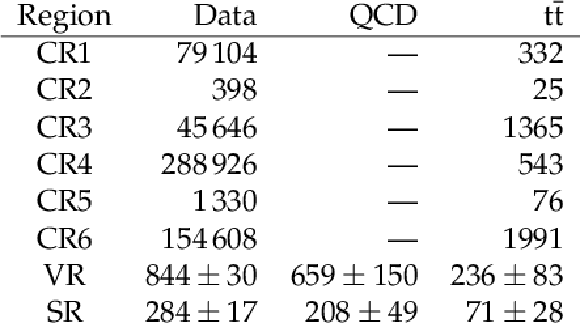
png pdf |
Table 4:
Event yield table after various selections. The definition of each region is given in Table 1. The uncertainties shown here for the validation region and the signal region are pre fit; the posteriori uncertainties for $ {{\mathrm {t}\overline {\mathrm {t}}}} $ and QCD are constrained down by 40 and 14%, respectively. |
| Summary |
| A search for a heavy W' boson decaying to a B or T vector-like quark and a top or b quark, respectively, has been presented. The data correspond to an integrated luminosity of 35.9 fb$^{-1}$ collected in 2016 with the CMS detector at the LHC. The signature considered for both decay modes is a top quark and a Higgs boson, both decaying hadronically, and a b quark jet. Boosted heavy-resonance identification techniques are used to exploit the event signature of three energetic jets and to suppress standard model backgrounds. No significant deviation from the standard model background prediction has been observed. Cross section upper limits on W' boson production in the top quark, Higgs boson, and b quark decay mode are set as a function of the W' mass, for several vector-like quark mass hypotheses. These are the first limits for W' boson production in this decay channel, and cover a range of 0.01 to 0.43 pb in the W' mass range between 1.5 and 4.0 TeV. |
| References | ||||
| 1 | M. Schmaltz and D. Tucker-Smith | Little Higgs theories | Ann. Rev. of Nucl. and Part. Sci. 55 (2005) 229 | hep-ph/0502182 |
| 2 | T. Appelquist, H.-C. Cheng, and B. A. Dobrescu | Bounds on universal extra dimensions | PRD 64 (2001) 035002 | hep-ph/0012100 |
| 3 | R. N. Mohapatra and J. C. Pati | Left-right gauge symmetry and an 'isoconjugate' model of CP violation | PRD 11 (1975) 566 | |
| 4 | CMS Collaboration | Search for heavy gauge W' boson in events with an energetic lepton and large missing transverse momentum at $ \sqrt{s} = $ 13 TeV | PLB 770 (2017) | CMS-EXO-15-006 1612.09274 |
| 5 | ATLAS Collaboration | Search for a new heavy gauge boson resonance decaying into a lepton and missing transverse momentum in 36 fb$ ^{-1} $ of $ pp $ collisions at $ \sqrt{s} = $ 13 TeV with the ATLAS experiment | EPJC 78 (2018) 401 | 1706.04786 |
| 6 | CMS Collaboration | Search for a heavy resonance decaying to a pair of vector bosons in the lepton plus merged jet final state at $ \sqrt{s}= $ 13 TeV | JHEP 05 (2018) 088 | CMS-B2G-16-029 1802.09407 |
| 7 | ATLAS Collaboration | Search for WW/WZ resonance production in $ \nu $qq final states in pp collisions at $ \sqrt{s} = $ 13 TeV with the ATLAS detector | JHEP 03 (2018) 042 | 1710.07235 |
| 8 | CMS Collaboration | Searches for $ \mathrm{W'} $ bosons decaying to a top quark and a bottom quark in proton-proton collisions at 13 TeV | JHEP 08 (2017) 029 | CMS-B2G-16-016 1706.04260 |
| 9 | ATLAS Collaboration | Search for $ W' \rightarrow tb $ decays in the hadronic final state using pp collisions at $ \sqrt{s}= $ 13 TeV with the ATLAS detector | PLB 781 (2018) 327 | 1801.07893 |
| 10 | CMS Collaboration | Search for single production of a vector-like T quark decaying to a Z boson and a top quark in proton-proton collisions at $ \sqrt{s} = $ 13 TeV | PLB 781 (2018) 574 | CMS-B2G-17-007 1708.01062 |
| 11 | CMS Collaboration | Search for single production of vector-like quarks decaying to a b quark and a Higgs boson | JHEP 06 (2018) 031 | CMS-B2G-17-009 1802.01486 |
| 12 | ATLAS Collaboration | Search for pair- and single-production of vector-like quarks in final states with at least one $ Z $ boson decaying into a pair of electrons or muons in $ pp $ collision data collected with the ATLAS detector at $ \sqrt{s} = $ 13 TeV | 1806.10555 | |
| 13 | CMS Collaboration | Search for single production of vector-like quarks decaying into a b quark and a W boson in proton-proton collisions at $ \sqrt s = $ 13 TeV | PLB 772 (2017) 634 | CMS-B2G-16-006 1701.08328 |
| 14 | CMS Collaboration | Search for pair production of vector-like quarks in the bWbW channel from proton-proton collisions at $ \sqrt{s} = $ 13 TeV | PLB 779 (2018) 82 | CMS-B2G-17-003 1710.01539 |
| 15 | CMS Collaboration | Search for vector-like T and B quark pairs in final states with leptons at $ \sqrt{s} = $ 13 TeV | CMS-B2G-17-011 1805.04758 |
|
| 16 | ATLAS Collaboration | Combination of the searches for pair-produced vector-like partners of the third-generation quarks at $ \sqrt{s} = $ 13 TeV with the ATLAS detector | 1808.02343 | |
| 17 | K. Agashe, R. Contino, and A. Pomarol | The minimal composite Higgs model | NPB 719 (2005) 165 | hep-ph/0412089 |
| 18 | D. Barducci et al. | Exploring drell-yan signals from the 4d composite higgs model at the lhc | JHEP 04 (2013) 152 | 1210.2927 |
| 19 | D. Barducci and C. Delaunay | Bounding wide composite vector resonances at the lhc | JHEP 02 (2016) 55 | 1511.01101 |
| 20 | N. Vignaroli | New W$ ' $ signals at the LHC | PRD 89 (2014) 095027 | 1404.5558 |
| 21 | CMS Collaboration | CMS luminosity measurements for the 2016 data taking period | CMS-PAS-LUM-17-001 | CMS-PAS-LUM-17-001 |
| 22 | CMS Collaboration | The CMS experiment at the CERN LHC | JINST 3 (2008) S08004 | CMS-00-001 |
| 23 | CMS Collaboration | Particle-flow reconstruction and global event description with the CMS detector | JINST 12 (2017) P10003 | CMS-PRF-14-001 1706.04965 |
| 24 | M. Cacciari, G. P. Salam, and G. Soyez | The anti-$ {k_{\mathrm{T}}} $ jet clustering algorithm | JHEP 04 (2008) 063 | 0802.1189 |
| 25 | M. Cacciari, G. P. Salam, and G. Soyez | Fastjet user manual | EPJC 72 (2012) 1896 | 1111.6097 |
| 26 | D. Bertolini, P. Harris, M. Low, and N. Tran | Pileup per particle identification | JHEP 10 (2014) 059 | 1407.6013 |
| 27 | CMS Collaboration | Jet energy scale and resolution in the CMS experiment in pp collisions at 8 TeV | JINST 12 (2017) P02014 | CMS-JME-13-004 1607.03663 |
| 28 | CMS Collaboration | The CMS trigger system | JINST 12 (2017) P01020 | CMS-TRG-12-001 1609.02366 |
| 29 | S. Frixione, P. Nason, and C. Oleari | Matching NLO QCD computations with parton shower simulations: the POWHEG method | JHEP 11 (2007) 070 | 0709.2092 |
| 30 | S. Alioli, P. Nason, C. Oleari, and E. Re | A general framework for implementing NLO calculations in shower Monte Carlo programs: the POWHEG BOX | JHEP 06 (2010) 043 | 1002.2581 |
| 31 | P. Nason | A new method for combining NLO QCD with shower Monte Carlo algorithms | JHEP 11 (2004) 040 | hep-ph/0409146 |
| 32 | S. Frixione, P. Nason, and G. Ridolfi | A positive-weight next-to-leading-order Monte Carlo for heavy flavour hadroproduction | JHEP 09 (2007) 126 | 0707.3088 |
| 33 | J. Alwall et al. | The automated computation of tree-level and next-to-leading order differential cross sections, and their matching to parton shower simulations | JHEP 07 (2014) 079 | 1405.0301 |
| 34 | J. Alwall et al. | Comparative study of various algorithms for the merging of parton showers and matrix elements in hadronic collisions | EPJC 53 (2008) 473 | 0706.2569 |
| 35 | T. Sjostrand et al. | An introduction to PYTHIA 8.2 | CPC 191 (2015) 159 | 1410.3012 |
| 36 | CMS Collaboration | Investigations of the impact of the parton shower tuning in Pythia 8 in the modelling of $ \mathrm{t\overline{t}} $ at $ \sqrt{s}= $ 8 and 13 TeV | CMS-PAS-TOP-16-021 | CMS-PAS-TOP-16-021 |
| 37 | CMS Collaboration | Event generator tunes obtained from underlying event and multiparton scattering measurements | EPJC 76 (2016) 155 | CMS-GEN-14-001 1512.00815 |
| 38 | GEANT4 Collaboration | GEANT4--a a simulation toolkit | NIM506 (2003) 250 | |
| 39 | CMS Collaboration | Jet algorithms performance in 13 TeV data | CMS-PAS-JME-16-003 | CMS-PAS-JME-16-003 |
| 40 | J. Thaler and K. Van Tilburg | Maximizing boosted top identification by minimizing N-subjettiness | JHEP 02 (2012) 093 | 1108.2701 |
| 41 | M. Dasgupta, A. Fregoso, S. Marzani, and G. P. Salam | Towards an understanding of jet substructure | JHEP 09 (2013) 029 | 1307.0007 |
| 42 | A. J. Larkoski, S. Marzani, G. Soyez, and J. Thaler | Soft drop | JHEP 05 (2014) | 1402.2657 |
| 43 | CMS Collaboration | Identification of heavy-flavour jets with the CMS detector in pp collisions at 13 TeV | JINST 13 (2018) P05011 | CMS-BTV-16-002 1712.07158 |
| 44 | CMS Collaboration | Search for massive resonances decaying into $ WW $, $ WZ $, $ ZZ $, $ qW $, and $ qZ $ with dijet final states at $ \sqrt{s}=13\text{}\text{}\mathrm{TeV} $ | PRD 97 (2018) 072006 | CMS-B2G-17-001 1708.05379 |
| 45 | CMS Collaboration | Measurement of differential cross sections for top quark pair production using the lepton+jets final state in proton-proton collisions at 13 TeV | PRD 95 (2017) 092001 | CMS-TOP-16-008 1610.04191 |
| 46 | J. S. Conway | Incorporating nuisance parameters in likelihoods for multisource spectra | in Proceedings, PHYSTAT 2011 workshop on statistical issues related to discovery claims in search experiments and unfolding, CERN,Geneva, Switzerland 17-20 January 2011, p. 115 2011 | 1103.0354 |
| 47 | CMS Collaboration | Measurement of the inelastic proton-proton cross section at $ \sqrt{s}= $ 13 TeV | JHEP 07 (2018) 161 | CMS-FSQ-15-005 1802.02613 |
| 48 | NNPDF Collaboration | Parton distributions from high-precision collider data | EPJC 77 (2017) 663 | 1706.00428 |
| 49 | R. Barlow and C. Beeston | Fitting using finite Monte Carlo samples | CPC 77 (1993) 219 | |

|
Compact Muon Solenoid LHC, CERN |

|

|

|

|

|

|